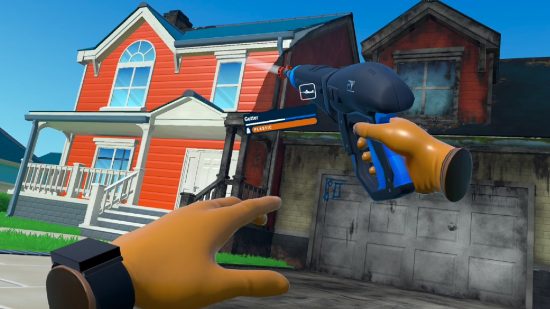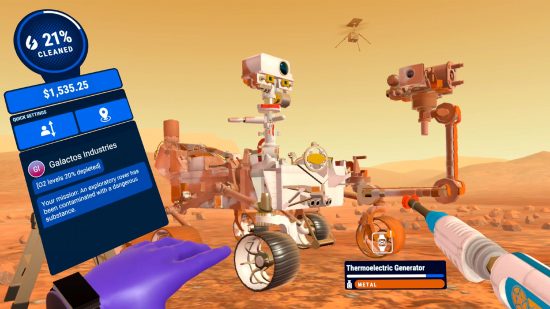Our Verdict
Never before has a game felt more at home on VR when compared to its PC counterpart. PowerWash Sim VR sets a new standard for the care and attention to detail that devs must now meet when porting their games into virtual reality.
It’s rare that an indie game survives its initial spike in interest to become a great game that’s enjoyed by the masses. It’s even rarer when said game translates so well to virtual reality that it ends up being the perfect way to play, yet that is exactly what has happened with PowerWash Simulator VR.
Futurlab has taken a hit game and made it one of the best VR games you can play today. It’s remarkable that as we wait for VR experiences such as Assassin’s Creed Nexus and Asgard’s Wrath 2 to show us how massive RPGs are possible, a small indie game about power-washing provided the most child-like joy I’ve had with the Meta Quest 3 so far.
There are zero compromises made in PowerWash Simulator VR, and this is a more feature-rich version when compared to the PC or console ports. The VR version has ruined the other editions for me, I’m having so much immersive fun that this is the only way I can play PowerWash Simulator from now on.

The main reason for this is its simplicity. While a tutorial is in place to help you learn the ropes, PWS VR is intuitively mapped out across the Quest 3 controllers. What results is a game that will mesmerize you for hours on end, or at least until your Quest 3 battery runs dry.
While I had some thoughts about how you might interact with your washer and change heads, extensions, and cleaners, the actual implementation of this in-game is far better than anything I imagined. PowerWash Simulator VR uses the common ‘belt’ inventory system with a twist, utilizing the virtual reality nature of the game to encourage me to grab the belt and spin it around to reach the tools I’m searching for. It took a little while to get to grips with, but it became second nature after I’d completed a couple of jobs.
The range of comfort options is expansive to help less-experienced VR players become accustomed to removing the training wheels. One slight flaw here is that as a left-handed player, I wasn’t able to keep movement on the left thumbstick because it automatically moved over to the right controller, which I still haven’t fully adjusted to. There’s a bug in the build I’m playing which means smooth turning with the thumbstick isn’t possible. Both options in the menu only allow for snap movement as a result, so hopefully this can be fixed for the full release.
Unexpected player agency exists within PWS VR that is incredibly handy. There’s the option to click a thumbstick to switch between standing, crouching, and prone positions, or just assume the positions in real life. For movement, the preference can be changed between smooth and teleportation by looking at the watch and selecting a toggle button, or the menu options present an alternative way to turn this on or off. Multiple ways to change preferences are welcomed, and it doesn’t stop here. By moving my non-washing hand up to my power washer’s head I can change the orientation, pull a trigger, or alter the spray angle on the fly. All of this goes to show that when Futurlab says it has achieved 1:1 optimization in PowerWash Simulator VR, it means it.

Having spent plenty of time on the PC version of the game, PowerWash Simulator VR doesn’t skip any content between versions. There’s one very noticeable difference in gameplay, but it comes as a massive benefit to VR. Dirt disappears a lot quicker even without using the additional cleaning solutions, which doesn’t make the game easier but helps the VR version move at a faster pace without compromising the integrity of the task at hand.
Multiplayer in PowerWash Simulator VR is a riot, as up to three other players can be invited to join jobs. Setting a job from open to co-op is easily managed from the tablet menu, which is also where other players’ sessions are joined. It’s a cozy cooperative option that is entirely harmless but a fun way to socialize with the potential to lead to unbridled chaos.
Not everyone will be adjusted to VR, and the battery life of the Quest headsets can be poor without a power bank, so being able to spend an appropriate amount of time in-game is crucial. I should also note that compared to other more intense games, like Vampire: The Masquerade – Justice, PWS VR isn’t a huge battery drainer. From a full charge, after an hour of play my battery had only dropped to around 75%. This puts it among the least taxing games in terms of power, as I usually get around three hours of gameplay from a fully charged Quest 3 battery.
This leads me into the performance of PowerWash Simulator VR, which runs incredibly well on the Meta Quest 3. Loading times are short and there’s no stuttering or slowdown in any area of the game. I spent all of my time with the game on a review build rather than a complete one, but this bodes well for the final version of the game as things stand unless unexpected bugs make their way into the full release.
PowerWash Simulator VR is the only way to play if you have access to compatible hardware. It’s a smooth and calming game that thrives in its new virtual reality format. While I find it hard to believe I could convince anyone to buy a VR headset based on one game alone, PWS VR is a great way to sell VR to the uninitiated.
